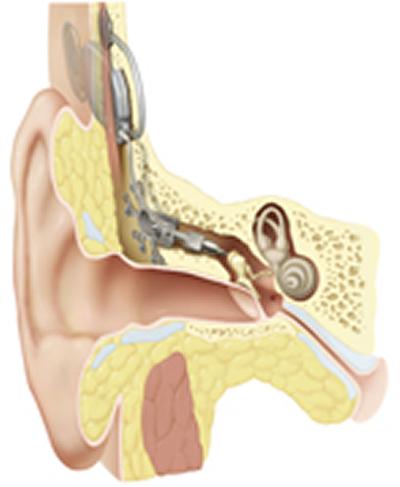Portsmouth woman receives UK’s first totally implanted hearing aid
A woman from Portsmouth has received the UK’s first totally implantable hearing aid thanks to the work of the South of England Cochlear Implant Centre (SOECIC), based at the University of Southampton.
The Otologics ‘Carina’ middle ear implant is special because it is the first totally implantable device to provide hearing with no external components for the user. The device consists of a rechargeable battery, a signal processor and a microphone which are all implanted under the skin. These are connected to a tiny electromagnetic vibrator which is positioned inside the mastoid bone behind the ear and attaches to the hearing bones. There is nothing on the outside of the head and the ear canal is left open.
In the past the microphone and battery were on the outside of the patient, held in place over the implanted part of the device by a magnet. This external part was still visible and prone to being knocked off or damaged or getting wet. When the external part was removed, for instance at night, or in the shower or swimming, the patient could no longer hear.
The implant is suitable for people with moderate to severe hearing losses who are unable to gain benefit from conventional hearing aids because of ear canal infections, allergies to ear moulds or a closed ear canal.
Sarah Flynn, Adult Programme Coordinator for SOECIC, explains how the implant works: “It works by delivering a mechanical vibration directly to the hearing bones. The microphone picks up sound from under the skin and transmits it to the signal processor. The signal processor amplifies the sound based on the user’s needs and transmits the amplified signal to the middle ear transducer. The transducer is positioned in a mounting system that allows it to contact and directly stimulate the hearing bones.
The main advantage of this approach is to bypass the external ear canal and deliver mechanical vibration directly to the hearing bones, avoiding the side effects of ear moulds.”

The recipient of the implant is Denise Westgate, a 49-year old woman from Havant in Portsmouth. She lost her hearing when she was six-years old and because of a closed right ear canal, she couldn’t wear a conventional hearing aid. Denise says: “I was nervous being the first person to undergo this operation but the difference it has made to my life is enormous. Suddenly there is all this sound that hasn’t been there before, something as simple as the sound of water when I am washing my hair or the sound of my husband’s lighter.
“I have to use a charger to charge the internal battery for about 45 minutes every day but other wise there is no external equipment to wear. I can leave it on overnight and can swim and shower with it in place.”
The operation was carried out at Queen Alexandra Hospital in Portsmouth by Consultant Otolaryngologist, Mike Pringle. Mike, who earlier this summer conducted UK’s first operation to fit a single cochlear implant capable of giving sound in both ears, explained how the middle ear implant differs from a cochlear implant: “A cochlear implant is for people whose hearing is too bad for a hearing aid. A cochlear implant goes into the inner ear and directly stimulates the hearing nerve.
“The Otologics Carina implant is a middle ear implant. It is for people with a moderate to severe hearing loss who could benefit from a hearing aid but are unable to use a hearing aid for a variety of reasons, the commonest being ear canal infections. The Carina implant directly vibrates the hearing bones which are in the middle ear. The Carina implant is also totally implantable so the battery, microphone and signal processor are all under the skin, leaving the ear canal open.”
Denise is currently undergoing auditory rehabilitation at SOECIC to encourage her listening with the new sensation she is experiencing. This is an individual programme using a computer to assess the levels and frequencies of sound that Denise can hear and tune the implant accordingly.